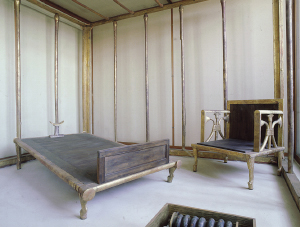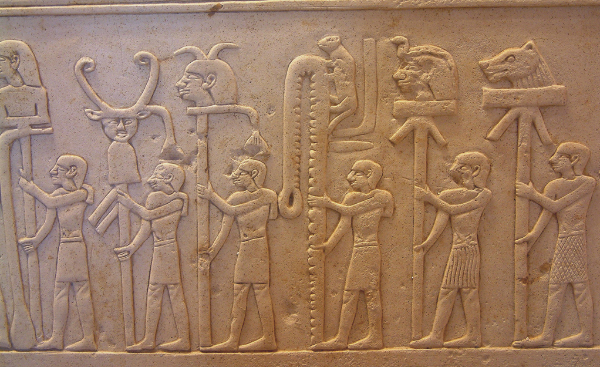The First Census of Israel’s Military (1:1–54)
Tent of Meeting (1:1). Israel’s worship center is known from Egyptian sources dating to as early as the Old Kingdom period (2700–2200 B.C.). Kitchen demonstrates parallels of several Egyptian “dismountable tabernacles” of the third through second millennia B.C.5 Mobile tent shrines with wooden pillars are depicted in ritual purification scenes on tomb murals.6 These structures used vertical and horizontal poles, metal fittings of copper, gold, or silver, and draped fabrics.
The war tent of Ramesses II presents a similar style of mobile sanctuary. Also the “secular tabernacle” of Queen Hetepheres, mother of Khufu (ca. 2600 B.C.), consisted of wooden poles and horizontal frames, assembled with tendon and socket joints. Gold decorations adorned the poles.7 Other mobile sanctuaries are known from Mari (eighteenth century B.C.) and Ugarit (thirteenth century B.C.), the latter contemporary with Moses.8 The Ugaritic Keret Texts use the same term mšknt.hm (“their tents”) as the Hebrew hammiškān (“the tent,” 3:7) for the mobile sanctuary. From the Mari texts of the Middle Bronze Age (2000–1550 B.C.), tents are described as being supported by wooden frames, called qeršu in Akkadian (cognate to the Heb. qerāšîm, “frames”).9 The Ugaritic term qeršu describes the tent of El in the Baal Epic.10

Tabernacle model
Becky Barden/www.BiblePlaces.com
Desert of Sinai (1:1). On the location of Mount Sinai and route taken by the Israelites, see the introduction.
First day of the second month of the second year (1:1). This chronological statement places the military conscription census on a “New Moon” festival, a year and two weeks after the Exodus, which took place on the 14th of Abib (=Nisan), the first month. This notation also occurs after the events described in chapters 7–9. The presentation of gifts by the twelve tribes for the service of the tabernacle (7:1–89) took place at the conclusion of the construction of the mobile shrine, which Exodus 40:17 places on Abib 1, almost a year after the Exodus. Then came the second Passover, celebrated on Abib 14 (Num. 9:1–5). The Israelite departure from Sinai took place on the twentieth day of the second month, less than three weeks after the census. See chart on “Chronology of Events in Exodus, Leviticus, and Numbers” at 7:1.

Portable structure contains remains of furniture found in the Giza tomb of Hetep-heres I, the chief queen of Sneferu and mother of Khufu.
Werner Forman Archive/The Egyptian Museum, Cairo
Take a census (1:2). A census for military conscription purposes was common in the Bible and texts of the ancient Near East (cf. Num. 25; 2 Sam. 24:1–17; 1 Chron. 21:1–17). In numerous other cases, a simple total of the military conscripted for battle is given.11 The census involved a head count—the idiomatic Hebrew terminology reads literally “lift up the head” and “every male by their skulls”—of capable military men age twenty years and up.
A troop census before going to battle was common in the warfare plans of ancient Sumer, Akkad, and Assyria. Sargon of Akkad (ca. 2350 B.C.) had an army of 5,400 who dined at his table after victories in Amurru.12 His son and heir to the throne fought with armies of 10,000 or more. In terms of the sizes of armies conquered, Shalmaneser I (ca. 1275–1245 B.C.) claims to have slaughtered 14,400 Hittites and Ahlamu troops.13
Twenty years old or more (1:3). Twenty years of age was the accepted age of full maturity in the Bible for military conscription (cf. 26:2; 2 Chron. 25:5), even though marriage often took place in the late teens. This age requirement is confirmed in the Dead Sea Scrolls.14 No upper age limit is given, though military capability is delineated. Levitical service began at age thirty, with an upper limit of fifty (Num. 4:3, 23, 30). Milgrom notes that twenty was the military age requirement in Sparta, though eighteen was the minimum at Athens.15
Total number (1:46). The large numbers in Exodus and Numbers have long posed problems for interpreters. With an able militia of over 600,000 and an additional population of 22,273 Levites, the total population of Israel coming out of Egypt would have easily exceeded two million (cf. also Ex. 12:37; 30:12–16; 38:26; Num. 11:21). Internal evidence from the Bible and external data cause considerable difficulty in accepting these figures at face value. See sidebar on “Large Numbers in the Book of Numbers.”
Levi (1:47–51). The three clans of the Levites are not counted in the military conscription census because of their noncombatant role. Priests in ancient Near Eastern societies were similarly not required to carry arms in battle, but served to carry symbols of the national deity(s) into battle and do other nonfighting functions. Though the Levites are not technically priests—that position is restricted to those in the direct line of Aaron—they perform duties similar to those in the priestly circles of ancient Ugarit, Mari, Emar, Assyria, and Babylon.16
Standard (1:52). Comparison of the Hebrew degel with the usage of Akkadian terms dagalu and diglu in the second millennium B.C. suggests that this is something that is seen (e.g., a banner or flag), which served as an identity feature for the given tribal troop unit.17 In later Hebrew and Aramaic this term refers to a military troop unit of a thousand men who lived together with their families and functioned as a legal and economic entity.18 Milgrom notes: “This situation corresponds closely to the makeup and function of the Israelite tribes in the wilderness.”19

Priests carrying standards
Guillaume Blanchard/Wikimedia Commons, courtesy of the Louvre